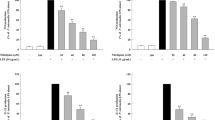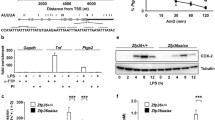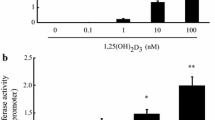Abstract.
In previous studies we found that the calciotropic hormone 1,25-dihydroxyvitamin D3 [1,25(OH)2D3] augments the action of either prostaglandin E1 (PGE1) or NaF to induce differentiation of human promyelocytic HL-60 cells, a process that features increased generation of nitric oxide (NO) via up-regulation of inducible nitric oxide synthase (iNOS). We have now examined the short-term interaction of 1,25(OH)2D3 with phorbol 12-myristate 13-acetate (PMA) and dimethylsulfoxide (DMSO) in these cells. PMA (100 nM) alone generally up-regulated several classical indices of macrophagic differentiation and stimulated cellular production of interleukin (IL)-1α, IL-6, tumor-necrosis factor (TNF)-α, PGE2, and NO. Increased generation of NO primarily resulted from increased expression of cellular iNOS. When 1,25(OH)2D3 (10 nM) was added to PMA treatments, most PMA-induced changes, particularly its effects to up-regulate iNOS-dependent NO production and change cell morphology, were multiplicatively augmented. In contrast, DMSO (1.3%) alone, an inducer of granulocytic differentiation, increased cytokine production, but failed to stimulate NO production or induce iNOS. In contrast to its striking interaction with PMA, 1,25(OH)2D3 could not augment DMSO's differentiative effects. Changes in cellular cytokine production were eliminated as the driving force in HL-60 differentiation when specific neutralizing antibodies failed to produce any attenuation of iNOS up-regulation or of the shifts in cell morphology. However, indomethacin (30 μM) blocked the synergistic interaction between 1,25(OH)2D3+ PMA to shift cell morphology and stimulate NO production. Subsequently adding PGE2 (1 ng/ml) to indomethacin-treated cells restored the ability of 1,25(OH)2D3+ PMA to interactively increase cellular NO production, but failed to fully replicate the strong shift in cell morphology typical of PMA + 1,25(OH)2D3 treatments. Our findings suggest that interaction between 1,25(OH)2D3 and PMA to induce macrophagic differentiation increases iNOS-dependent NO production by a mechanism involving a cyclooxygenase product(s), possibly PGE2.
Similar content being viewed by others
Author information
Authors and Affiliations
Additional information
Received: 13 March 1997 / Accepted: 14 November 1997
Rights and permissions
About this article
Cite this article
Kawase, T., Orikasa, M., Oguro, A. et al. Up-Regulation of Inducible Nitric Oxide (NO) Synthase and NO Production in HL-60 Cells Stimulated to Differentiate by Phorbol 12-Myristate 13-Acetate Plus 1,25-Dihydroxyvitamin D3 Is Not Obtained With Dimethylsulfoxide Plus 1,25-Dihydroxyvitamin D3 . Calcif Tissue Int 63, 27–35 (1998). https://doi.org/10.1007/s002239900485
Issue Date:
DOI: https://doi.org/10.1007/s002239900485




